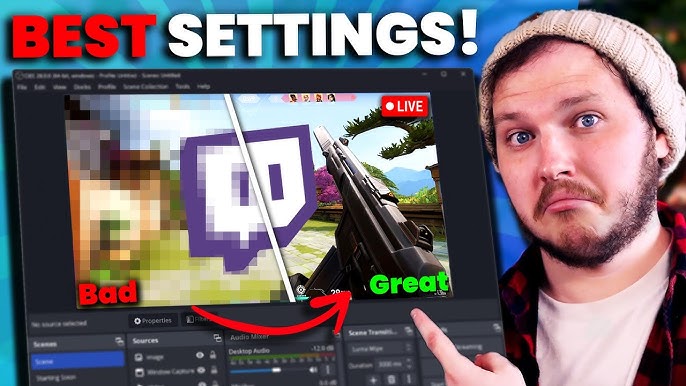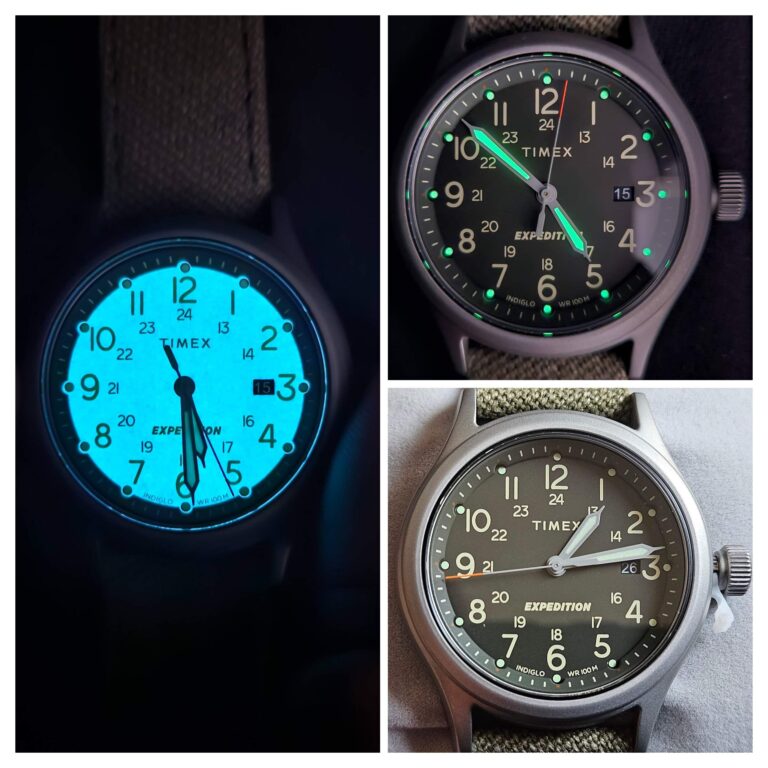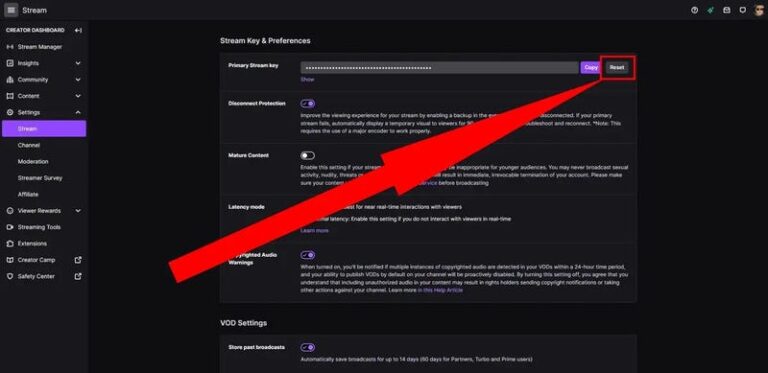Why is My Stream Lagging on Twitch? Top Solutions and Tips
Experiencing lag during a Twitch stream can be frustrating. It disrupts the viewing experience and can drive away your audience.
But why does it happen? Lagging on Twitch can occur for many reasons. Sometimes, your internet connection might be the culprit. Other times, your computer’s performance may be to blame. Understanding the root cause is essential to fixing the problem and ensuring smooth streaming.
Whether you’re a seasoned streamer or new to the platform, knowing why your stream lags is the first step to improving the quality of your broadcasts. In this blog, we will explore common causes of Twitch lag and offer solutions to help you stream without interruptions. Let’s dive in and troubleshoot this issue together.

Credit: www.youtube.com
Common Causes Of Stream Lag
Stream lag on Twitch can be frustrating for viewers and streamers. Understanding the common causes can help you fix these issues and improve your stream quality.
Internet Speed Issues
One major cause of stream lag is slow internet speed. Streaming requires a stable and fast connection. If your internet speed is low, your stream will lag.
Check your upload speed. Twitch recommends at least 3 Mbps for streaming. If your speed is lower than this, you may need to upgrade your internet plan.
Another factor is network congestion. During peak hours, many users are online, which can slow down your internet. Try streaming at different times to see if it improves.
Hardware Limitations
Your computer hardware can also affect stream quality. If your CPU or GPU is not powerful enough, it can struggle to process the video data.
Streaming software can be resource-intensive. Ensure your computer meets the minimum requirements for the software you use.
Running multiple applications while streaming can slow down your system. Close unnecessary programs to free up resources.
Check your drivers and update them regularly. Outdated drivers can cause performance issues and contribute to stream lag.
Checking Your Internet Connection
Experiencing lag on Twitch can be frustrating. The first step to fix this is to check your internet connection. A strong, stable connection is crucial for smooth streaming. Below are steps to ensure your internet is up to the task.
Run A Speed Test
Running a speed test can help you understand your internet’s performance. Use tools like Speedtest.net to measure your download and upload speeds. For Twitch streaming, aim for at least 3 Mbps upload speed.
If your speeds are lower, contact your internet service provider. They might offer a plan with higher speeds. Consistent low speeds could mean hardware issues.
Optimize Wi-fi Settings
Wi-Fi settings play a big role in streaming quality. First, place your router in a central location. This helps the signal reach all areas of your home.
Next, reduce interference. Keep your router away from walls and other electronics. Devices like microwaves can disrupt your Wi-Fi signal.
Also, switch to the 5 GHz band if your router supports it. This band is less crowded and offers faster speeds.
Lastly, secure your network. Set a strong password to prevent others from using your bandwidth. This ensures you have enough speed for smooth streaming.
Hardware Requirements For Streaming
Streaming on Twitch requires a powerful computer. Your hardware affects your stream’s quality. If your stream lags, your hardware might be the issue. Understanding the hardware requirements for streaming can help you improve your stream’s performance.
Minimum Specs
To stream on Twitch, your computer must meet certain minimum specs. You need at least an Intel Core i5-4670 processor. A similar AMD processor works too. Your RAM should be at least 8GB. The GPU should be an NVIDIA GTX 600 or an AMD Radeon HD 7000 series.
These specs ensure your stream runs, but they are the bare minimum. Your computer might struggle with higher quality settings. This can cause lag, especially during intense gaming moments.
Recommended Upgrades
For a better streaming experience, consider upgrading your hardware. An Intel Core i7 or AMD Ryzen 7 processor is a good start. Upgrade your RAM to 16GB or more. This helps with multitasking while streaming.
For the GPU, an NVIDIA GTX 1060 or AMD RX 580 is ideal. These upgrades can handle higher quality streams. Your viewers will enjoy a smoother experience. Your computer will also perform better during gaming.
Consider a solid-state drive (SSD) for faster load times. It can improve overall system performance. Cooling systems are also important. They keep your computer from overheating during long streams.
Optimizing Streaming Software
Are you frustrated with your Twitch stream lagging? Optimizing your streaming software can be the key to a smoother experience. Let’s dive into some practical ways to enhance your stream quality.
Adjust Bitrate
Bitrate directly affects the quality and stability of your stream. A higher bitrate means better video quality, but it requires more bandwidth.
If your stream is lagging, try lowering the bitrate. This reduces the data being sent, which can help if your internet connection isn’t strong.
Experiment with different settings to find the sweet spot between quality and performance. Use tools like Twitch Inspector to monitor your stream’s health.
Select Appropriate Encoder
The encoder you choose can make a significant difference in your stream performance. Software encoders like x264 provide high-quality streams but can be demanding on your CPU.
Alternatively, hardware encoders like NVENC or AMD VCE use your GPU, which can free up your CPU for other tasks. This can be particularly helpful if you’re gaming and streaming from the same machine.
Check your streaming software settings and switch to a hardware encoder if you notice performance issues. This can often resolve lagging without compromising too much on quality.
Optimizing your streaming software doesn’t have to be complicated. With a few tweaks to bitrate and encoder settings, you can significantly improve your Twitch streaming experience. What adjustments have you found to be most effective in your streaming setup?
Network Settings Tweaks
Stream lag on Twitch can be frustrating. Network settings tweaks can often help. By adjusting a few settings, you can improve your stream’s performance. Let’s explore some effective tweaks.
Port Forwarding
Port forwarding allows your network to direct internet traffic more efficiently. This can reduce lag. Access your router settings. Look for port forwarding options. Add the necessary ports for Twitch. You may need to refer to Twitch’s support site for specific port numbers. This setting helps your stream data get priority.
Wired Vs. Wireless
A wired connection is usually more stable than wireless. Using an Ethernet cable can improve your connection. It reduces interference. Wireless connections can be unstable. Other devices and walls can affect the signal. Switch to a wired setup if possible. This simple change can reduce lag significantly.
Reducing Background Processes
Reducing background processes can help improve your Twitch stream performance. Close unnecessary applications to free up system resources. This can lead to smoother streaming and less lag.
Reducing Background Processes If you’re asking, “Why is my stream lagging on Twitch?” one major culprit could be background processes. These silent resource hogs can significantly affect your streaming performance. By reducing background processes, you can free up valuable system resources, ensuring a smoother and more enjoyable streaming experience.Close Unnecessary Applications
Start by closing any applications that you don’t need while streaming. Applications like browsers, email clients, or messaging apps can consume a lot of your system’s resources. For instance, having multiple browser tabs open can eat up your RAM and CPU usage. Close them to allocate more resources to your streaming software. Check your task manager to see which applications are running. Close the ones you don’t need to streamline your system’s performance.Limit System Resource Usage
Another effective way to reduce background processes is to limit how much system resource each application can use. You can do this by setting the priority level of your streaming software to “High” in your task manager. This tells your computer to allocate more resources to it. Additionally, disable any startup programs that are not essential. This can help your system run more efficiently from the moment you boot up. Are there any applications that you always forget to close? Make it a habit to check and shut them down before you start streaming. This simple step can make a huge difference in your stream’s performance.Choosing The Right Streaming Platform
Choosing the right streaming platform is crucial for your Twitch experience. Not only can it affect the quality of your stream, but it can also impact your audience engagement and growth. Let’s dive into how choosing the right platform can help you avoid those annoying lag issues.
Twitch Vs. Alternatives
Twitch is the go-to platform for many streamers, but it’s not the only option. Other platforms like YouTube Gaming and Facebook Gaming also offer robust streaming services.
If your stream is constantly lagging on Twitch, it might be worth exploring these alternatives. Each platform has its own strengths and weaknesses, and what works for one streamer might not work for another.
Consider what you need most—is it a larger audience, better monetization options, or perhaps a more stable streaming experience? Trying out different platforms can provide new insights and help you find the best fit.
Platform-specific Settings
Each streaming platform comes with its own set of settings. These can significantly influence your stream’s performance. On Twitch, you have options like bitrate, resolution, and frame rate that you can tweak to reduce lag.
Other platforms might offer different settings. YouTube Gaming, for instance, allows for higher bitrates, which can improve stream quality but may require a stronger internet connection.
Take the time to understand each platform’s settings. Adjust them according to your internet speed and hardware capabilities. This can make a huge difference in reducing lag and providing a smoother viewing experience for your audience.
Have you tried adjusting your settings or switching platforms to see if it helps? Experimenting with these options can lead to surprising improvements in your streaming quality.
Testing Your Stream
Testing your stream can help identify why your Twitch stream is lagging. By conducting test streams and monitoring stream health, you can pinpoint the issues. This will help improve the viewer experience. Let’s dive into how to properly test your stream.
Conducting Test Streams
Before going live, start with a test stream. Use Twitch’s “Stream Manager” to create a test stream. This allows you to check your settings without broadcasting to all followers.
Make adjustments to your bitrate, resolution, and frame rate. Experiment to find the best settings for your internet speed. Test streams can reveal if your computer can handle streaming and gaming at the same time.
Monitoring Stream Health
Use Twitch’s “Stream Health” tool to monitor your stream. This tool shows real-time data on your stream’s performance. Pay attention to key metrics such as dropped frames, bitrate, and CPU usage.
Dropped frames often indicate network issues. Low bitrate could mean your internet speed is too slow. High CPU usage suggests your computer is struggling. Addressing these issues can reduce lag and improve the quality of your stream.
Regular monitoring helps you quickly spot and fix problems. This ensures a smoother viewing experience for your audience.
Helpful Tools And Resources
Experiencing lag during your Twitch stream can be frustrating. Fortunately, there are helpful tools and resources to diagnose and fix these issues. Whether you’re new to streaming or a seasoned pro, these recommendations can make a significant difference.
Streaming Software Recommendations
Choosing the right streaming software is crucial. Popular options like OBS Studio, Streamlabs OBS, and XSplit are designed to optimize performance. These programs offer customizable settings to suit your unique needs.
OBS Studio is a favorite due to its flexibility and open-source nature. You can tweak various settings to reduce lag. Streamlabs OBS, while based on OBS Studio, provides a more user-friendly interface. XSplit is another solid option, offering high-quality streams with minimal setup.
Have you tried updating your streaming software? Outdated versions can cause lag. Regular updates ensure compatibility with the latest systems and features.
Community Forums And Support
When troubleshooting lag, community forums can be a goldmine of information. Websites like Reddit and Twitch’s own support forums are packed with advice from experienced streamers.
Reddit’s r/Twitch subreddit has countless threads discussing lag issues. You can find solutions to common problems or post your own queries. Engaging with the community can lead to quick fixes.
Twitch’s support forums are also valuable. They offer official advice and resources. Plus, you can connect with Twitch staff for direct assistance.
Have you ever thought about joining a Discord server dedicated to Twitch streaming? Many servers have channels specifically for technical support. Getting real-time help can be a game-changer.
Remember, the right tools and community support can help you overcome streaming lag. Are you ready to explore these resources and enhance your Twitch experience?

Credit: www.reddit.com

Credit: www.youtube.com
Frequently Asked Questions
How Do I Fix My Twitch Stream Lag?
To fix Twitch stream lag, lower your stream bitrate, close background applications, and use a wired internet connection. Adjust your stream settings, and update your graphics drivers.
Why Is My Stream Lagging With Good Internet?
Your stream may lag due to device performance issues, outdated software, network congestion, or high CPU usage. Ensure your device and apps are up-to-date.
Why Does My Twitch Stream Look Choppy?
Your Twitch stream may look choppy due to low internet speed, high CPU usage, or incorrect stream settings. Reduce bitrate, lower resolution, and close unnecessary programs to improve stream quality.
How Do I Fix Stuttering While Streaming?
To fix stuttering while streaming, reduce video quality, close background applications, update drivers, and optimize internet connection. Adjust encoder settings and ensure your hardware meets streaming requirements.
Conclusion
Lagging on Twitch can be frustrating. Check your internet speed first. Optimize your streaming settings for better performance. Close unnecessary background applications. Update your software and hardware regularly. Test different streaming times to avoid peak hours. Seek help from online forums or support groups.
These steps can improve your streaming experience. Keep streaming and enjoy your time on Twitch!






